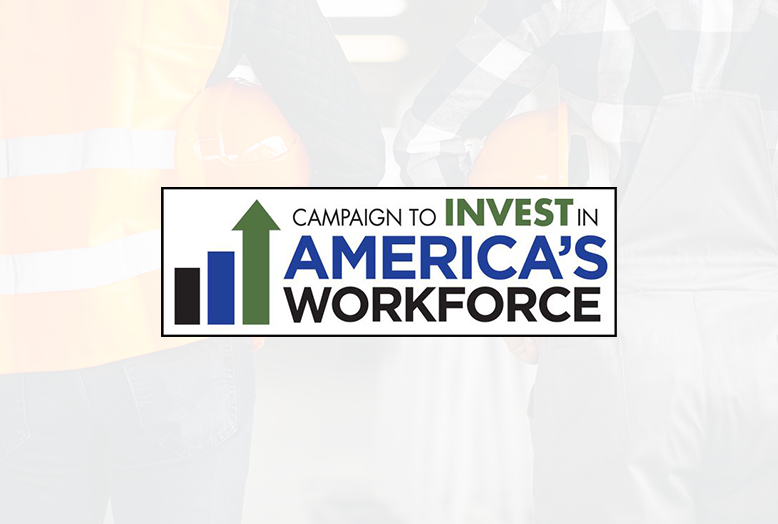CIAW Writes Letter to President Trump from Workforce Coalition
January 23, 2025
The Honorable Donald J. Trump
The White House
1600 Pennsylvania Avenue, NW
Washington, DC 20500
Dear Mr. President,
Congratulations on your election and inauguration. We look forward to working with you on behalf of the American people to strengthen our nation’s economy and highlight the power of work.
We are writing as part of the Campaign to Invest in America’s Workforce (CIAW), a coalition dedicated to growing our economy by strengthening the investment in America’s workforce. Our organizations are committed to meeting the needs of workers, learners, and employers across the nation, helping people of all ages pursue education, develop in-demand skills, and secure family-sustaining employment without the need for a four-year college degree and the immense debt one may incur.
We urge you to increase and strengthen investments in workforce development programs as part of the forthcoming reconciliation bill and the federal fiscal year 2026 budget and appropriations process. These investments yield substantial dividends for America, as evidenced by increased wages, tax revenue, labor force participation, and U.S. competitiveness, while also reducing reliance on public assistance.
For example, FutureWork Systems analyzed the most recently released U.S. Department of Labor data and found that services under Title I and Title III the Workforce Innovation and Opportunity Act (WIOA) – an annual investment of $3.84 billion – resulted in an estimated $61.6 billion in annual earnings for almost 1.5 million job seekers.
The return on investment is quite powerful: for every $1 invested in WIOA, the economy sees approximately $15.03 in wages earned. Investing in American workers is clearly a cost-effective federal investment which benefits our entire nation.
A strong return on investment is also found with WIOA Title II funds, with an average $750 investment per adult learner resulting in an annual wage increase of more than $2,600.
WIOA’s impact extends beyond individual paychecks. Addressing workforce shortages keeps businesses open, ensures families receive essential goods, and supports vital community services. Equipping workers with the in-demand skills of today’s economy is essential for businesses and industries and is a vital strategy for ensuring the U.S. economy remains the world’s most powerful growth engine. A skilled workforce reduces reliance on public assistance, increases tax revenue, and strengthens business profitability.
Congress must ensure workforce development programs that serve youth and adults under WIOA— including Wagner-Peyser and Adult Education, the Perkins Career and Technical Education Act, apprenticeships, community service employment for older workers, and workforce adjacent programs—that prepare all individuals for sustainable and high-quality employment, receive the necessary resources to effectively address current workforce realities.
Investing in the public workforce system is arguably among the federal government’s most worthwhile and remunerative programs in terms of supporting families, businesses, and communities, while bolstering local economies by generating billions of dollars in wages.
The Campaign to Invest in America’s Workforce thanks you for your leadership and commitment to a strong American workforce, and we welcome the opportunity to further discuss these issues with you.
Sincerely,
Association for Career and Technical Education
Association of Farmworker Opportunity Programs (AFOP)
Coalition on Adult Basic Education (COABE)
Commercial Vehicle Training Association
Council for Adult and Experiential Learning (CAEL)
Goodwill Industries International, Inc.
Local Initiatives Support Corporation (LISC)
National Association of Development Organizations
National Association of Regional Councils
National Association of Workforce Boards (NAWB)
National Association of Workforce Development Professionals
National Immigration Forum
The Corps Network
______________________________________________________________________________________
1 FutureWork Systems (futureworksystems.com) provides business intelligence applications specifically designed for the Workforce Development system.
2 USDOL’s latest data from the WIOA Individual Performance Records (Public Use, Participant Individual Record Layout (PIRL)) data for the rolling 4 quarter reporting period ending March 31, 2024 was used to calculate this amount. The average annual earnings of program participants after successfully gaining employment is approximately $41,000, which translates into $61.6 billion in earnings and economic impact. This calculation assumes full-year employment at second-quarter earnings levels, which may vary depending on job duration and wage changes.
3 The Economic Mobility Corporation study of Jewish Vocational Service in Boston, as reported in the Boston Globe https://www.bostonglobe.com/2020/11/23/business/language-success/. The study also found that unemployed residents with prior U.S. work experience who enrolled in an employment-focused English course boosted their annual earnings by more than $7,100.





